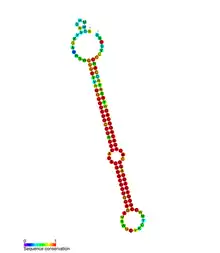miR-214
miR-214 is a vertebrate-specific family of microRNA precursors. The ~22 nucleotide mature miRNA sequence is excised from the precursor hairpin by the enzyme Dicer.[1] This sequence then associates with RISC which effects RNA interference.[2]
| miR-214 | |
|---|---|
 Conserved secondary structure of miR-214 microRNA precursor | |
| Identifiers | |
| Symbol | miR-214 |
| Alt. Symbols | MIR214 |
| Rfam | RF00660 |
| miRBase | MI0000290 |
| miRBase family | MIPF0000062 |
| NCBI Gene | 406996 |
| HGNC | 31591 |
| OMIM | 610721 |
| RefSeq | NR_029627 |
| Other data | |
| RNA type | miRNA |
| Domain(s) | Metazoa |
| GO | 0035195 |
| SO | 0001244 |
| Locus | Chr. 1 q24.3 |
| PDB structures | PDBe |
Origin and evolution of miR-214
miR-214 is a vertebrate-specific miR family that possesses one member in non-teleost vertebrates and two members in teleost fish. miR-214 is likely to have emerged within the Dnm3 gene after the divergence of jawed and jawless vertebrates and is located on the opposite strand of an intron of Dnm3 and is associated in an expression cluster with miR-199.[3]
Function
miR-214 is a "melano-miR",[4] so-called because it is thought to encourage the metastasis of melanoma. Specifically, the mature microRNA excised from miR-214 is predicted to target two activating protein 2 transcription factors, bringing about downstream effects on a number of genes regulating vital cell cycle processes, such as apoptosis, proliferation and angiogenesis.[4]
miR-214 is also thought to regulate type-I collagen.[5]
Role in cancer
miR-214 has been found to be downregulated in human cervical cancer; when miR-214 was upregulated in HeLa cancer cells, it was found to significantly reduce cell growth.[6] Two mRNA targets were identified as those encoding the proteins MAP2K3 and MAPK8.[6]
The increased expression of miR-214 in pancreatic cancer could bring about increased resistance to chemotherapy.[7]
In human glioma cell line T98G expression of miR-214 has been shown to suppress expression of the ubiquitin-conjugating enzyme 9 (UBC9) and reduces tumour cell proliferation. The protein UBC9 is involved in the sumoylation pathway, and is up-regulated in many cancers.[8]
Implication of miR-214 in skeletogenesis
miR-214, along with its cluster mate miR-199, has been shown to be implicated in skeleton formation. miR-214 has been shown to inhibit bone formation in human cell lines both by targeting ATF4,[9] a gene encoding one of the maintranscription factors required for osteoblast function and by suppressing osteogenic differentiation of C2C12 myoblast cells by targeting Sp7,[10] an osteoblast-specific transcription factor. Also, Twist-1, which is a major actor in skeleton formation, regulates miR-199 and miR-214 cluster expression in mouse.[11] Furthermore, miR199-214 cluster deletion in mouse lead to skeletal development abnormalities including craniofacial defects, neural arch and spinous processes malformations, and osteopenia.[12] In zebrafish, miR-214 expression is mainly observed around developing skeletal elements.[3]
References
- Ambros V (December 2001). "microRNAs: tiny regulators with great potential". Cell. 107 (7): 823–6. doi:10.1016/S0092-8674(01)00616-X. PMID 11779458.
- Gregory RI, Chendrimada TP, Cooch N, Shiekhattar R (November 2005). "Human RISC couples microRNA biogenesis and posttranscriptional gene silencing". Cell. 123 (4): 631–40. doi:10.1016/j.cell.2005.10.022. PMID 16271387.
- Desvignes T, Contreras A, Postlethwait JH (2014). "Evolution of the miR199-214 cluster and vertebrate skeletal development". RNA Biology. 11 (4): 281–94. doi:10.4161/rna.28141. PMC 4075512. PMID 24643020.
- Bar-Eli M (May 2011). "Searching for the 'melano-miRs': miR-214 drives melanoma metastasis". The EMBO Journal. 30 (10): 1880–1. doi:10.1038/emboj.2011.132. PMC 3098491. PMID 21593728.
- Maubach G, Lim MC, Chen J, Yang H, Zhuo L (June 2011). "miRNA studies in in vitro and in vivo activated hepatic stellate cells". World Journal of Gastroenterology. 17 (22): 2748–73. doi:10.3748/WJG.v17.i22.2748. PMC 3122263. PMID 21734783.
- Yang Z, Chen S, Luan X, Li Y, Liu M, Li X, Liu T, Tang H (November 2009). "MicroRNA-214 is aberrantly expressed in cervical cancers and inhibits the growth of HeLa cells". IUBMB Life. 61 (11): 1075–82. doi:10.1002/iub.252. PMID 19859982.
- Zhang XJ, Ye H, Zeng CW, He B, Zhang H, Chen YQ (November 2010). "Dysregulation of miR-15a and miR-214 in human pancreatic cancer". Journal of Hematology & Oncology. 3: 46. doi:10.1186/1756-8722-3-46. PMC 3002909. PMID 21106054.
- Zhao Z, Tan X, Zhao A, Zhu L, Yin B, Yuan J, Qiang B, Peng X (November 2012). "microRNA-214-mediated UBC9 expression in glioma". BMB Reports. 45 (11): 641–6. doi:10.5483/BMBRep.2012.45.11.097. PMC 4133799. PMID 23187003. Archived from the original on 2016-03-03.
- Wang X, Guo B, Li Q, Peng J, Yang Z, Wang A, Li D, Hou Z, Lv K, Kan G, Cao H, Wu H, Song J, Pan X, Sun Q, Ling S, Li Y, Zhu M, Zhang P, Peng S, Xie X, Tang T, Hong A, Bian Z, Bai Y, Lu A, Li Y, He F, Zhang G, Li Y (January 2013). "miR-214 targets ATF4 to inhibit bone formation". Nature Medicine. 19 (1): 93–100. doi:10.1038/nm.3026. PMID 23223004.
- Shi K, Lu J, Zhao Y, Wang L, Li J, Qi B, Li H, Ma C (August 2013). "MicroRNA-214 suppresses osteogenic differentiation of C2C12 myoblast cells by targeting Osterix". Bone. 55 (2): 487–94. doi:10.1016/j.bone.2013.04.002. PMID 23579289.
- Lee YB, Bantounas I, Lee DY, Phylactou L, Caldwell MA, Uney JB (January 2009). "Twist-1 regulates the miR-199a/214 cluster during development". Nucleic Acids Research. 37 (1): 123–8. doi:10.1093/nar/gkn920. PMC 2615617. PMID 19029138.
- Burkardt DD, Rosenfeld JA, Helgeson ML, Angle B, Banks V, Smith WE, Gripp KW, Moline J, Moran RT, Niyazov DM, Stevens CA, Zackai E, Lebel RR, Ashley DG, Kramer N, Lachman RS, Graham JM (June 2011). "Distinctive phenotype in 9 patients with deletion of chromosome 1q24-q25". American Journal of Medical Genetics. Part A. 155A (6): 1336–51. doi:10.1002/ajmg.a.34049. PMC 3109510. PMID 21548129.
